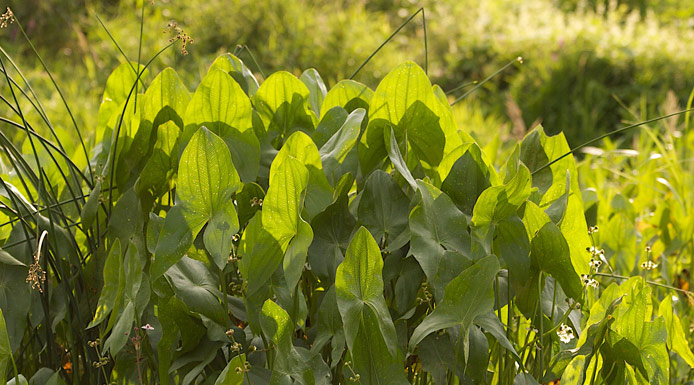WATERS OF LIFE
LIFE UNDERWATER
- VEGETATION
- INTRODUCTION VEGETATION
- BIODIVERSITY
- ENVIRONMENT AND ADAPTATIONS
- NUTRITION
- DISTRIBUTION
- RESEARCHER'S OPINION
VEGETATION - ENVIRONMENT AND ADAPTATIONS
![]() FLASH PLAYER IS REQUIRED TO SEE THE CONTENT OF THIS PAGE
FLASH PLAYER IS REQUIRED TO SEE THE CONTENT OF THIS PAGE

Île de Grâce Bay
The large sheltered bays, gently sloping banks and shallow waters of Lake Saint-Pierre make it an ideal environment for vast stands of emergent and submerged plants to grow.

Aquatic plants play an important role in slowing erosion by reducing the force of waves and retaining soil with their roots.

The plants form a kind of bulwark against the waves.
VIDEO - 0 min 12 s
This video shows the movement of water lilies and bulrushes in the wetlands.

Arrowheads
They also absorb suspended matter from the tributaries. This promotes sedimentation and improves water clarity.

Damselfly on a Water-lily leaf
Aquatic plants provide habitat for an abundant and varied fauna.

The Great Blue Heron hides among the stems to fish undisturbed.

A smaller wader, the Least Bittern, hunts insects from the stems or leaves of cattails. This rare bird, classified as vulnerable in Quebec, also makes its nest out of cattails.

The Black Tern uses aquatic plants to build its nest.

Aquatic plants are an ideal place for Black Tern chicks to hide from predators.

The same is true of Common Moorhen chicks.

Common Moorhen
This bird walks on the leaves of aquatic plants, hunting insects and gastropods.

Muskrats are very common in the wetlands around Lake Saint-Pierre. These rodents eat cattail stems and leaves. Their homes are built of branches.
LIFE UNDERWATER
VEGETATION
- INTRO VEGETATION
- BIODIVERSITY
- ENVIRONMENT AND ADAPTATIONS
- NUTRITION
- DISTRIBUTION
- RESEARCHER'S OPINION
